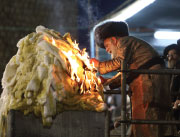All Fired Up
| May 10, 2017
To put it in perspective the logistics involve over 500000 visitors 5 000 policemen and 9 000 buses all within a 24-hour period. For accidents and emergencies — of which there are many — several organizations are on hand: Ezer Mizion Ichud Hatzolah Zaka and Magen David Adom. One of the buildings in the Bnei Akiva yeshivah high school compound at the top of the mountain is transformed into a field hospital (Photos: Flash90)
"H e who has not seen the Simchas Beis Hashoeivah in the Beis Hamikdash has not seen true simchah in his days.” But until we merit the glory of the Beis Hamikdash Hashlishi it’s probably fair to borrow the Mishnah’s statement in describing the electrifying atmosphere at the tomb of Rabi Shimon Bar Yochai on Lag B’omer.
That day — which sees a pilgrimage of half a million Jews flocking up the mountain through the village of Meron in an awe-inspiring display of unity and joy — is the Jewish world’s biggest annual gathering.
But how does this small moshav — whose pathways were originally paved for donkey carts — and a stone structure built 450 years ago over the tomb of Rashbi handle the huge influx? It takes tremendous manpower and even greater brainpower to orchestrate this gargantuan operation in a way that both safety and tradition are preserved and these days Rabbi Yosef Schwinger of Jerusalem the frontrunner behind its logistics is busier than ever.
Ready for Anything
The name Yossi Schwinger is a buzzword in the Israeli media. As chairperson of the government-funded Center for the Development of Holy Sites Rabbi Schwinger is in the unenviable tug-of-war position of being the go-to person when it comes to everything related to holy sites around the country whether it’s a renovation desecration political controversy security detail or anything in between. And of all the holy sites his name is attached to — Kever Rochel Kever Shimon Hatzaddik Kever Dovid Hamelech — the Lag B’omer pilgrimage to Meron is by far his most complex project.

This year there are 18 official hadlakos each one slotted in to a time and place
“In a span of 24 hours you have over half a million people converging on this quiet moshav from all over Israel and beyond” he explains. “Men women children babies. We have to think of every possible scenario and be prepared to deal with every situation.”
It wasn’t easy to schedule a conversation so close to Lag B’omer. He had back-to-back meetings — with the chief of police with the various emergency services with representatives of all the major chassidic courts. And between those intense meetings his phone rings off the hook. Having to juggle so many needs of so many conflicting interests the unruffled rabbi lamented that every year during this hectic time “I make new enemies.”
Perfect Timing
They say money can solve everything but all the millions in the world won’t make Meron any bigger. Still while the physical part of organizing Lag B’omer is a struggle the financial restrictions make it even tougher. The government allocates 14 million NIS to the annual Meron operation but says Rabbi Schwinger it’s still very tight. Both Minister of Religious Affairs Rabbi David Azulai and Interior Minister Rabbi Aryeh Deri have been lobbying for the Treasury to increase the Lag B’omer budget but so far it’s status quo.
To put it in perspective the logistics involve over 500 000 visitors 5 000 policemen and 9 000 buses all within a 24-hour period. For accidents and emergencies — of which there are many — several organizations are on hand: Ezer Mizion Ichud Hatzolah Zaka and Magen David Adom. One of the buildings in the Bnei Akiva yeshivah high school compound at the top of the mountain is transformed into a field hospital. With this handful of teams presiding over one colossal mass the coordination and deployment of the personnel is enormous. (Excerpted from Mishpacha Issue 659)
Oops! We could not locate your form.













